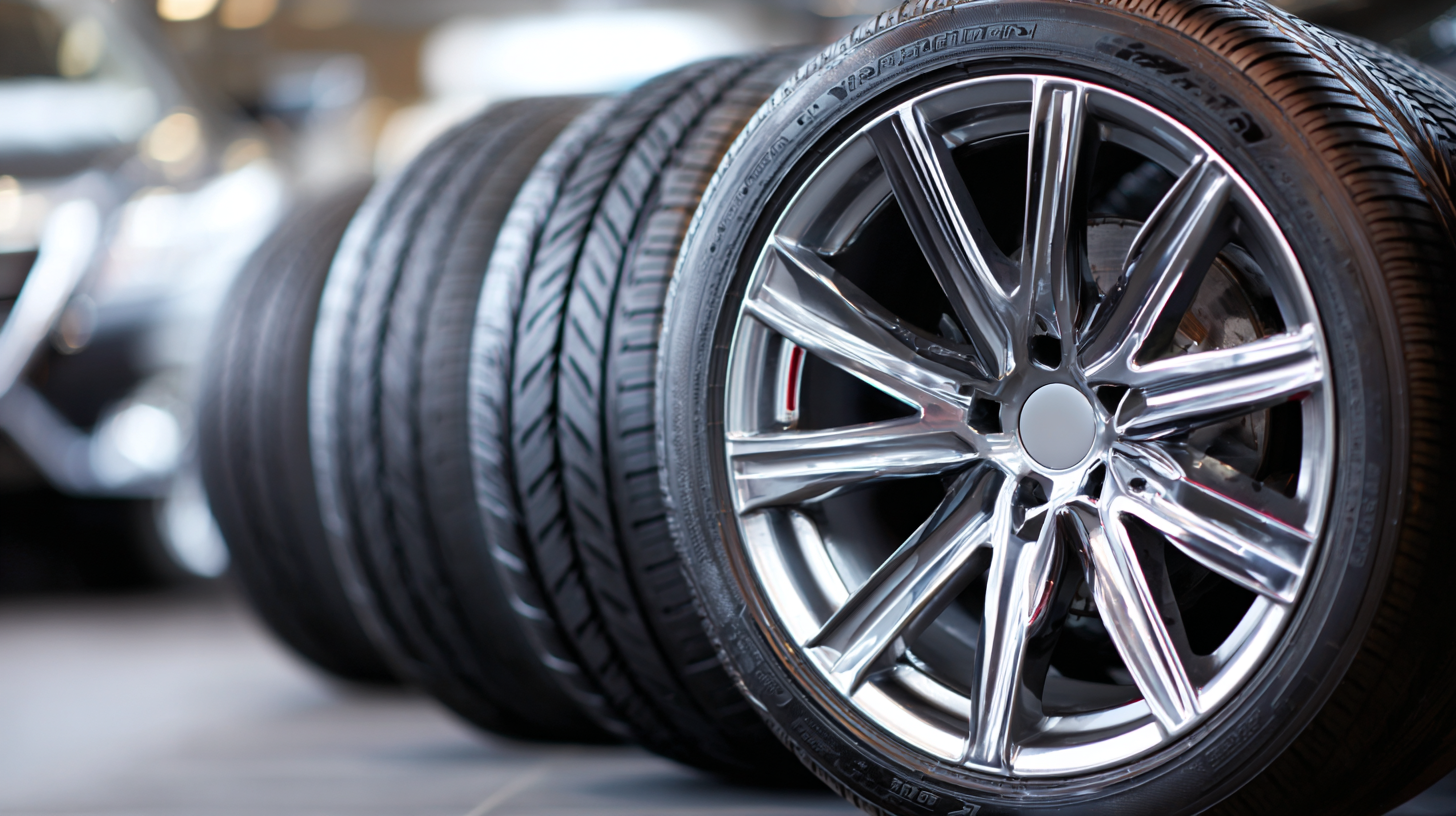Choosing the right car tires is crucial for ensuring optimal performance, safety, and fuel efficiency of your vehicle. In a world where technology and tire designs are constantly evolving, finding the perfect match for your car can be daunting. According to John Smith, an industry expert with over 20 years of experience in tire manufacturing and evaluation, “The right set of car tires can significantly enhance your vehicle’s handling and performance, making them one of the most important investments for any car owner.”
In this comprehensive guide, we will explore the key factors that influence the choice of car tires, such as size, tread pattern, and seasonality. With the plethora of options available in the market, it’s essential to understand how the right tires can impact your driving experience. Whether you’re looking for all-season tires for daily commutes or high-performance tires for spirited drives, we will provide insights into how to navigate these choices effectively.
By the end of this guide, you’ll be equipped with the knowledge to select car tires that not only meet your specific driving needs but also ensure safety and comfort on the road. With the right tire selection, you can unlock your vehicle's full potential while enjoying peace of mind in every journey.

When choosing the right tires for your vehicle, understanding tire specifications is crucial, particularly the sidewall markings. These markings provide essential information about the tire's size, construction, load capacity, and speed rating. For example, a typical marking might read P215/65R15 95H. Here, "P" indicates it’s a passenger tire, "215" is the width in millimeters, "65" refers to the aspect ratio, "R" specifies radial construction, "15" is the diameter of the wheel in inches, "95" denotes the load index, and "H" indicates the speed rating. A study by the Tire Association reveals that nearly 70% of consumers overlook these crucial details, which can lead to improper tire selection.
**Tips:** Always cross-reference the vehicle owner’s manual for tire specifications. Additionally, consulting the manufacturer's website can provide valuable insights into compatible tires for your make and model.
Reading and interpreting these sidewall markings not only helps in selecting suitable tires but also ensures safety and performance. According to the National Highway Traffic Safety Administration, improper tire selection can significantly increase the risk of tire blowouts and accidents. Hence, being informed about the specifications aids in making educated choices, supporting both the longevity of your tires and the safety of your driving experience.
**Tips:** Consider opting for tires that exceed the recommended load index for added safety, especially if you frequently carry heavy loads or drive in challenging conditions.
| Tire Specification | Description |
|---|---|
| Tire Width | The width of the tire in millimeters, measured from sidewall to sidewall. |
| Aspect Ratio | The ratio of the sidewall height to the tire width, expressed as a percentage. |
| Construction Type | Indicates the type of internal construction; common types include radial (R) and bias-ply (D). |
| Rim Diameter | Diameter of the wheel rim in inches that the tire is designed to fit. |
| Load Index | Numerical code associated with the maximum load capacity of the tire. |
| Speed Rating | Letter indicating the maximum speed a tire can safely maintain over time. |
| Tread Pattern | Design of the tire surface that affects traction, handling, and noise levels. |
| Seasonality | Indicates whether tires are all-season, summer, or winter-specific. |
When it comes to selecting the right tires for your vehicle, understanding the different types available is crucial. All-season tires, for instance, are designed to provide adequate performance in a variety of conditions, from wet to dry and even light snow. According to the Tire Industry Association, about 60% of North American drivers opt for all-season tires due to their versatility and convenience, making them a popular choice for year-round use. These tires boast a symmetric tread pattern that enhances stability and traction, though they may not perform optimally in extreme weather conditions.
In contrast, winter tires are specifically engineered to handle severe cold and snowy conditions. The rubber compound remains flexible, and the tread pattern features deeper grooves and biting edges, which significantly enhance grip on ice and snow. A study by the Rubber Manufacturers Association indicates that winter tires can improve braking performance by up to 40% on snow-covered roads compared to all-season tires. For enthusiasts or those requiring enhanced handling, performance tires offer improved traction and responsiveness during high-speed maneuvers. These tires typically utilize softer rubber compounds and unique tread designs for superior grip on both dry and wet roads, catering to drivers looking for a sportier driving experience.
This chart illustrates the average performance scores of various tire types based on key metrics: Traction, Durability, and Comfort. The performance scores are rated out of 10.
 When selecting the right car tires, understanding tread patterns is crucial as they significantly influence traction and handling. Tread patterns can be broadly categorized into three types: symmetrical, asymmetrical, and directional. According to the Tire Society, a well-maintained tread depth of at least 3mm is essential for optimal traction in wet conditions. Tires with deeper grooves help channel water away, thereby reducing hydroplaning risk and enhancing grip on slippery roads.
When selecting the right car tires, understanding tread patterns is crucial as they significantly influence traction and handling. Tread patterns can be broadly categorized into three types: symmetrical, asymmetrical, and directional. According to the Tire Society, a well-maintained tread depth of at least 3mm is essential for optimal traction in wet conditions. Tires with deeper grooves help channel water away, thereby reducing hydroplaning risk and enhancing grip on slippery roads.
Tips: Regularly inspect your tire tread for uneven wear and consider using a tread depth gauge to ensure they meet safety standards.
Choosing tires with the appropriate tread pattern can also affect mileage and performance. For example, tires with a more aggressive, off-road tread are suitable for rugged terrains but may compromise fuel efficiency on highways. Conversely, touring tires are designed for comfort and fuel economy, but provide less grip in extreme conditions. A report by the Consumer Tire Advocacy Group indicates that selecting the right tread can improve a vehicle's handling by up to 30% during adverse weather conditions.
Tips: Always refer to your vehicle manufacturer’s specifications to match the tire’s performance attributes with your driving habits.
Choosing the right tire size for your vehicle is crucial for optimal performance and safety. One of the most reliable sources for determining the correct tire size is the vehicle manufacturer’s recommendations, typically found in the owner's manual or on the driver's side door jamb. These specifications take into account various factors, including the vehicle's weight, handling characteristics, and safety features. Adhering to these guidelines ensures that your tires will fit properly, which is essential for maintaining good fuel efficiency and overall vehicle stability.
Tips: Always check your tire size before making a purchase. Look for the standardized markings on your existing tires, which indicate their size, speed rating, and load capacity. Additionally, consider consulting with a tire professional if you are considering changing your tire type or size, as they can provide valuable insights based on your driving habits and conditions.
Moreover, remember that using the manufacturer-recommended tire size can also influence your vehicle’s warranty. Improper sizes can lead to complications that may void your warranty, so it’s best to stay compliant with the stated specifications. Regularly inspecting your tires for wear and ensuring they are inflated to the correct pressure can also extend their lifespan and enhance your vehicle's performance.
Regular tire maintenance is essential not only for safety but also for enhancing the longevity and performance of your vehicle. One of the simplest yet most effective ways to maximize tire life is through consistent air pressure checks. Under-inflated tires can lead to decreased fuel efficiency and uneven wear, while over-inflated tires can cause reduced traction and an increased risk of blowouts. Aim to check your tires monthly, and always before long trips, to ensure they are at the manufacturer-recommended pressure.

In addition to monitoring air pressure, rotating your tires regularly is crucial. Tire rotation helps distribute wear evenly across all tires, promoting longevity. Most manufacturers suggest rotating your tires every 6,000 to 8,000 miles, but consult your owner’s manual for specific recommendations. Furthermore, keeping an eye on tread depth is vital; using the penny test can help you determine if your tires need replacing. By implementing these simple maintenance tips, you can significantly enhance your tires' performance and lifespan, ensuring a safer and more efficient driving experience.






Reignite your passion for driving with Yokohama tires and experience the superior performance you deserve.